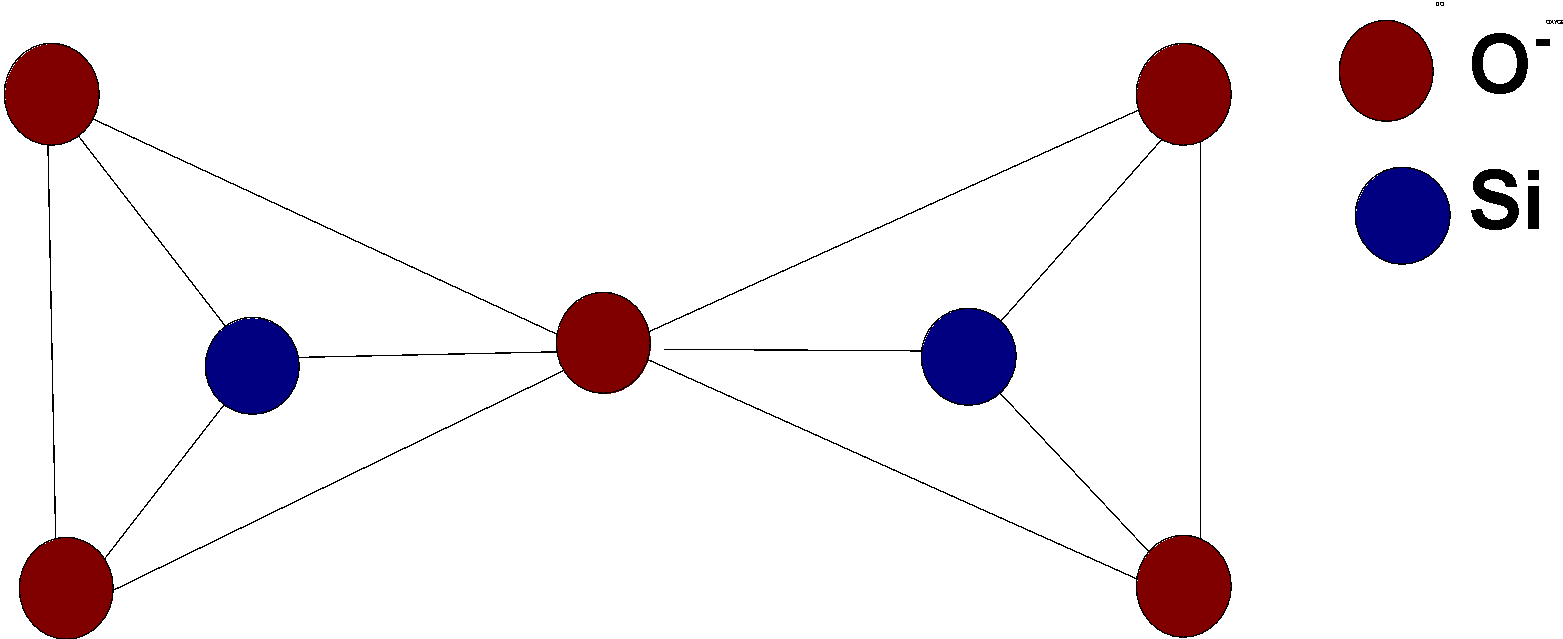
An example of pyrosilicate is:
A) Thortveitite
B) Willemite
C) Spodumene
D) Kaolinite
Answer
573k+ views
Hint: The silicate is formed by fusing an alkali with the$\text{ Si}{{\text{O}}_{\text{2}}}$. It exists in various allotropes like Orthosilicate, pyrosilicate, cyclic silicate, chain silicate, etc. The pyrosilicate consists of the $\text{ S}{{\text{i}}_{\text{2}}}\text{O}_{\text{7}}^{\text{6-}}$ anions which are joined together by the removal of oxygen. The thortveitite is an example of silicate, it is scandium yttrium silicate. $\text{ (Sc,Y}{{\text{)}}_{\text{2}}}\text{S}{{\text{i}}_{\text{2}}}{{\text{O}}_{\text{7}}}$
Complete step by step answer:
The $\text{ Si}{{\text{O}}_{\text{2}}}$ fuses with the alkali oxides to give silicates. This is discrete tetrahedral units. Since silicon is \[\text{ s}{{\text{p}}^{\text{3}}}\] hybridized. The various units are linked in several patterns and classified as follows,
1) Orthosilicate: Orthosilicate contains the separated $\text{ Si}{{\text{O}}_{4}}$units. This is linked together by various patterns. An example is Willemite$\text{ (ZrSi}{{\text{O}}_{\text{4}}}\text{)}$.
2) Pyrosilicate: In pyrosilicate, the two units are linked together by the oxygen atom. The simplest ion is\[\text{ S}{{\text{i}}_{\text{2}}}{{\text{O}}_{\text{7}}}\] . Example is Thortveitite\[\text{ S}{{\text{c}}_{\text{2}}}\left[ \text{S}{{\text{i}}_{\text{2}}}{{\text{O}}_{\text{7}}} \right]\]
3) Cyclic silicates: this allotrope shares the two oxygen atoms. The example is Beryl - \[\text{ B}{{\text{e}}_{\text{3}}}\text{A}{{\text{l}}_{\text{2}}}\text{S}{{\text{i}}_{\text{6}}}{{\text{O}}_{\text{18}}}\]
4) Chain silicates: these are formed by the linking of units to form a chain silicate. They are of two types:
i) Metasilicates
ii) Amphiboles
Now, we will discuss pyrosilicate. A pyrosilicate is a chemical compound that contains the phyllosilicate anion $\text{ S}{{\text{i}}_{\text{2}}}\text{O}_{\text{7}}^{\text{6-}}$ with the hexavalent group \[\text{ }-({{\text{O}}_{\text{3}}}\text{Si-O-Si}{{\text{O}}_{\text{3}}})-\] .
Pyrosilicate is formed by joining the two tetrahedral units$\text{ S}{{\text{i}}_{\text{2}}}\text{O}_{4}^{4-}$.this units joined together by the removal of oxygen and two units then join at the corners of oxygen atoms.
The structure of pyrosilicate is as follows:

One of the common examples of pyrosilicate is thortveitite. It is a scandium silicate yttrium silicate$\text{ (Sc,Y}{{\text{)}}_{\text{2}}}\text{S}{{\text{i}}_{\text{2}}}{{\text{O}}_{\text{7}}}$. It is a primary source of scandium.
Hence, (A) is the correct option.
Note: The silicon is a group 14 element and shows the allotropic properties. The
silicates have the silicon-oxide linkage but exist in a different structure. Students should remember the formulas for the silicates.
Complete step by step answer:
The $\text{ Si}{{\text{O}}_{\text{2}}}$ fuses with the alkali oxides to give silicates. This is discrete tetrahedral units. Since silicon is \[\text{ s}{{\text{p}}^{\text{3}}}\] hybridized. The various units are linked in several patterns and classified as follows,
1) Orthosilicate: Orthosilicate contains the separated $\text{ Si}{{\text{O}}_{4}}$units. This is linked together by various patterns. An example is Willemite$\text{ (ZrSi}{{\text{O}}_{\text{4}}}\text{)}$.
2) Pyrosilicate: In pyrosilicate, the two units are linked together by the oxygen atom. The simplest ion is\[\text{ S}{{\text{i}}_{\text{2}}}{{\text{O}}_{\text{7}}}\] . Example is Thortveitite\[\text{ S}{{\text{c}}_{\text{2}}}\left[ \text{S}{{\text{i}}_{\text{2}}}{{\text{O}}_{\text{7}}} \right]\]
3) Cyclic silicates: this allotrope shares the two oxygen atoms. The example is Beryl - \[\text{ B}{{\text{e}}_{\text{3}}}\text{A}{{\text{l}}_{\text{2}}}\text{S}{{\text{i}}_{\text{6}}}{{\text{O}}_{\text{18}}}\]
4) Chain silicates: these are formed by the linking of units to form a chain silicate. They are of two types:
i) Metasilicates
ii) Amphiboles
Now, we will discuss pyrosilicate. A pyrosilicate is a chemical compound that contains the phyllosilicate anion $\text{ S}{{\text{i}}_{\text{2}}}\text{O}_{\text{7}}^{\text{6-}}$ with the hexavalent group \[\text{ }-({{\text{O}}_{\text{3}}}\text{Si-O-Si}{{\text{O}}_{\text{3}}})-\] .
Pyrosilicate is formed by joining the two tetrahedral units$\text{ S}{{\text{i}}_{\text{2}}}\text{O}_{4}^{4-}$.this units joined together by the removal of oxygen and two units then join at the corners of oxygen atoms.
The structure of pyrosilicate is as follows:

One of the common examples of pyrosilicate is thortveitite. It is a scandium silicate yttrium silicate$\text{ (Sc,Y}{{\text{)}}_{\text{2}}}\text{S}{{\text{i}}_{\text{2}}}{{\text{O}}_{\text{7}}}$. It is a primary source of scandium.
Hence, (A) is the correct option.
Note: The silicon is a group 14 element and shows the allotropic properties. The
silicates have the silicon-oxide linkage but exist in a different structure. Students should remember the formulas for the silicates.
Recently Updated Pages
Master Class 11 Economics: Engaging Questions & Answers for Success

Master Class 11 English: Engaging Questions & Answers for Success

Master Class 11 Social Science: Engaging Questions & Answers for Success

Master Class 11 Biology: Engaging Questions & Answers for Success

Class 11 Question and Answer - Your Ultimate Solutions Guide

Master Class 11 Business Studies: Engaging Questions & Answers for Success

Trending doubts
What is meant by exothermic and endothermic reactions class 11 chemistry CBSE

10 examples of friction in our daily life

One Metric ton is equal to kg A 10000 B 1000 C 100 class 11 physics CBSE

Difference Between Prokaryotic Cells and Eukaryotic Cells

What are Quantum numbers Explain the quantum number class 11 chemistry CBSE

1 Quintal is equal to a 110 kg b 10 kg c 100kg d 1000 class 11 physics CBSE




